Engaging learners online is tough. Recent studies show that while half of all learners are enrolled in distance courses, only a third of instructors feel confident creating strong classroom communities online. The physical distance between everyone makes it harder to build those natural connections that fuel active learning.
Virtual icebreakers can help solve this problem. In order to create an active learning environment where members feel comfortable participating in questions and discussions, it’s important to set the right tone from the beginning. Done right, icebreakers are an effective tool for building meaningful connections in online sessions.
In this guide, we'll explore 25 proven virtual icebreakers designed specifically for online engagement with students and coworkers. Let’s start by explaining what a virtual icebreaker is and why having one ready for your next meeting or class can be so beneficial. Breaking the ice has never been easier!
We organized our icebreakers by length and type for easy finding - feel free to jump to the section that best fits your needs:
- Quick connection questions (5-7 minutes)
- Collaborative icebreakers (10-15 minutes)
- Reflection and discussion starters (10-15 minutes)
- Team-building games (15-20 minutes)
- Creative activities (15-20 minutes)
What Are Virtual Icebreakers?
Virtual icebreakers are engaging activities designed to lighten the mood at the beginning of a meeting or a class. They serve as excellent conversation starters, energizing participants, sparking lively discussions, and encouraging everyone to be more active throughout the session. In online and hybrid meetings, virtual icebreakers add a personal touch to video calls, helping colleagues or students connect and enjoy some social interaction.
The science is clear: people learn better and are more productive when they feel connected to their peers and instructors. This sense of belonging activates the brain's reward centers, making learning more enjoyable and memorable. In virtual environments, this connection becomes even more important.
You can use icebreakers at different times:
- At the start of the quarter or term to build community
- At the beginning of each session to energize participants
- During energy dips to revive participation
- Before difficult content to create a supportive atmosphere
- When forming teams to build group cohesion
Whether you opt for quick questions or more elaborate games, there’s an icebreaker to suit every preference!
How to Choose the Right Virtual Icebreaker
Picking the right icebreaker for your specific situation is key to success. Consider these factors:
Learning objectives: Match your icebreakers to your broader goals. If critical thinking matters in your session, choose activities that spark analytical discussion. If team building is important, use icebreakers that involve collaboration or sharing.
Think about which activities will work the best depending on your group size:
- Small classes (under 15): Individual sharing works well
- Medium classes (15-30): Use breakout groups with reporting back
- Large classes (30+): Try polling, chat features, or representative sharing
Be realistic about the time you have available:
- Quick activities (5-7 minutes): Perfect for regular class or meeting starters
- Medium activities (10-15 minutes): Good for weekly community building
- Extended activities (15-20 minutes): Best for project beginnings or major transitions
Use the tools available in your teaching platform:
- Breakout tables or rooms for small group discussions
- Polling features for quick engagement
- Whiteboard tools for collaborative creation
- Chat functionality for text-based sharing
Make sure all learners can participate fully:
- Provide multiple ways to participate (verbal, text, visual)
- Offer alternatives for those with limited technology
- Be mindful of time zone differences for asynchronous options
Best Icebreakers for Engaged Learning Online
Quick Connection Questions (5-7 minutes)
1. This or That Polls
How it works: Begin your session with a series of poll questions presenting two choices, either words or images. These can range from fun and light-hearted (like "Cats or dogs?") to course-related topics. After voting, invite volunteers to explain their choices.
Why it's effective: This activity not only lightens the mood but also sparks conversation and debate. Sharing poll results and encouraging learners to explain their choices to the whole class can lead to interesting discussions and insights into their personalities.
Implementation tips: Prepare 5-7 pairs of options beforehand. Use your platform's polling feature or simple hand-raising. Mix fun choices with course-relevant options to transition toward content. Consider putting students in small groups to discuss their choices.
Variations:
- Lifestyle choices: Country or city living? Planner or improviser? Morning or night person?
- Food preferences: Pancakes or waffles? Tacos or wings? Coffee or tea?
- Technology and hobbies: New phone or new laptop? Television series or movies? Board games or card games? Physical book or ebook?
- Learning preferences: Reading or listening? Theory or application? Individual or group work?
- Professional scenarios: Remote or in-person? Startup or established organization? Specialist or generalist?
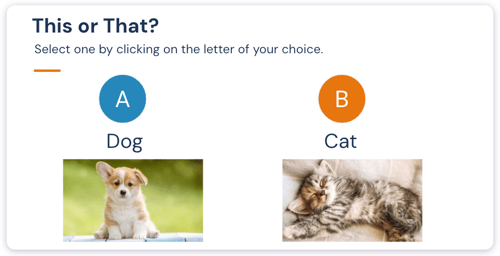
2. Geographic Introductions
How it works: Ask students to share their location and something interesting about that place. In live sessions, students can speak or type in chat. For asynchronous classes, create a discussion thread or collaborative map where students pin their locations and add comments.
Why it's effective: This creates visual connections between participants, celebrates diversity, and helps students find common ground based on location. It's especially valuable in courses with global participation.
Implementation tips: Try using interactive tools like Google Maps or a collaborative whiteboard where learners annotate a picture of a map for visual representation. Give clear prompts like "Share your location and one thing visitors should know about your area" or "Tell us about a hidden gem in your community."
Variations:
- Historical landmarks: Students share a significant historical site nearby
- Dream destinations: Students identify places they hope to visit and why
- Cultural highlights: Students share a tradition or celebration unique to their region
3. One-Word Check-In
How it works: Invite learners to describe their current state, reaction to a concept, or expectation for the session in a single word. Collect responses via chat, emojis, polling tools, or verbal sharing, then acknowledge patterns or interesting responses.
Why it's effective: This quick activity gives you an emotional temperature check of the class, allowing you to gauge energy levels and adjust accordingly. It helps students transition into the learning space through brief self-reflection. By regularly incorporating this activity, you can build a culture of openness within your class.
Implementation tips: Try word cloud tools to create visual representations of responses. Give clear context for the check-in, such as "One word describing your energy today" or "One word that comes to mind when you think about [session topic]."
Variations:
- Emotions: Students share their current emotional state
- Learning readiness: Students indicate their preparedness for the day's topic
- Topic associations: Students share their first reaction to the session's subject
- Weather report: Students describe their mood as a weather condition
4. Unexpected Skills
How it works: Ask students to share something unexpected they know how to do - a skill, ability, or area of knowledge that might surprise others. This can be done verbally, in chat, or through a discussion board.
Why it's effective: This highlights the diverse talents within the class, creating memorable connections between students. It helps break down academic hierarchies by recognizing valuable skills beyond course content.
Implementation tips: Model vulnerability by sharing your own unexpected skill first. Emphasize that skills can be serious or lighthearted, practical or unusual. Consider following up with questions about how students developed these abilities.
Variations:
- Unusual hobbies: Students share interesting pastimes
- Surprising facts: Students share something most people don't know about them
- Hidden talents: Students describe abilities they rarely get to showcase
- Past experiences: Students share unexpected jobs or roles they've held
5. Learning Goals Snapshot
How it works: Ask learners to share their main goal for the session, module, or course. This can be done through chat, discussion boards, or brief verbal statements.
Why it's effective: This connects students to the purpose of their learning, sets intentions for engagement, and gives you valuable information about expectations and priorities. It helps you tailor content to learner interests.
Implementation tips: Save responses to revisit later in the year for reflection on progress. Provide examples of specific, achievable goals to guide responses. Consider grouping similar goals to identify common themes.
Variations:
- Challenges: Learners identify aspects of the topic they find most difficult
- Opportunities: Learners share how they hope to apply the learning
- Questions: Learners pose one question they hope the course will answer
- Growth areas: Learners identify skills they hope to develop
READ MORE: 5 Ways to Increase Student Engagement in Online Education
Collaborative Icebreakers (10-15 minutes)
6. Two Truths and a Lie
How it works: Each learner shares three statements about themselves: two truths and one lie. The statements are shared with the rest of the class, who try to guess which one is the lie. To add a layer of challenge, encourage your students to make their truths as unbelievable as possible!
Why it's effective: This classic game serves multiple purposes - is great for laughter and surprise, encourages the class to think creatively, and is naturally engaging. It helps the class learn fun and interesting facts about each other while bonding over the personal connection.
Implementation tips: For larger classes, use breakout groups of 4-5 students. Encourage students to make their truths as unusual as possible and their lies plausible. Consider having students vote on the most surprising truth at the end.
Variations:
- Course-related version: Two true concepts and one misconception about the subject
- Future aspirations: Two genuine goals and one fake ambition
- Professional experience: Two real and one fake work experiences
- Learning journey: Two true and one false statement about their educational path
7. Virtual Background Challenge
How it works: Encourage learners to set a virtual background related to a fun theme, such as their favorite vacation spot or dream travel destination. These can include images of real places, photos from past trips taken by your learners, or even fictional worlds from books and movies. As each learner joins, they can briefly share the reason or story behind their background.
Why it's effective: The visual aspect of this icebreaker makes it memorable and enjoyable, and it can be enjoyed for the whole session if your learners keep their virtual backgrounds! As your learners share the stories behind their backgrounds, it naturally sparks conversations about shared interests and experiences.
Implementation tips: Provide platform-specific guidance for setting virtual backgrounds. Suggest alternatives for students whose devices don't support this feature, such as holding up a physical image or describing their imagined background. Send the theme in advance to allow preparation time.
Variations:
- Course concepts: Backgrounds representing key ideas from the course topics
- Historical periods: Images from a time period relevant to the course
- Aspirational settings: Places where students hope to apply their learning
- Book covers or film scenes: Media that relates to learner interests or course themes
8. Joyful Items Show and Tell
How it works: Turn off the cameras and microphones of your learners, then give them two minutes to find an item in their space that brings them joy or has a deeper story. Ask them to jot down some notes around the story or why the item brings them joy to collect their thoughts. In pairs, your learners can turn back on their cameras and share their items with a peer. Give them enough time to share and discuss. Once the pairs have shared, you can open up the room for anyone who would like to share their item's story with the whole class.
Why it's effective: This exercise brings a personal touch to the virtual classroom, allowing learners to connect on a more personal level. It’s a gentle way to open up and share a piece of their world. Keeping the discussion one-on-one at first allows learners to share their stories in a safe, intimate setting.
Implementation tips: Provide a structured sharing format (e.g., 2 minutes per person) to manage time effectively. Model by sharing your own meaningful object first.
Variations:
- Course-related items: Objects that connect to the subject matter
- Cultural artifacts: Items that represent students' cultural backgrounds
- Learning tools: Objects that symbolize students' approaches to learning
- Inspirational items: Things that motivate or inspire learners
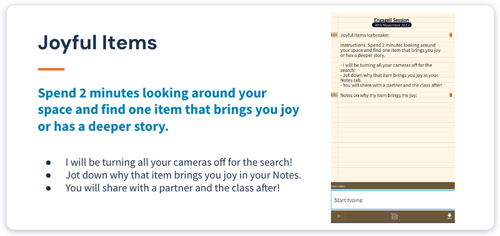
9. Collaborative Brainstorming Session
How it works: This icebreaker is great for helping learners construct ideas and detail their thinking to develop solutions. Give learners 5 minutes to think on their own about a particular topic. During this independent thinking time, encourage them to take notes to organize their thoughts. Then, bring the whole class together around a virtual whiteboard, flowchart, mind map, or scrum board. Ask everyone to add their ideas via sticky notes. You can then use these class-generated ideas to launch a discussion and determine next steps.
Why it's effective: This activity fosters collaborative thinking and creativity. It’s particularly effective for more in-depth discussions and brainstorming sessions, particularly when you want to highlight student-led solutions.
Implementation tips: Use digital collaboration tools like Miro or Engageli's native whiteboard. Provide clear categories or sections for organizing ideas. After collection, facilitate a brief discussion about patterns, unique contributions, or next steps.
Variations:
- Problem-solving challenges: Addressing issues related to the field
- Case studies: Analyzing situations from multiple perspectives
- Creative prompts: Generating innovative approaches or applications
- Prediction exercises: Forecasting developments or outcomes in the subject area
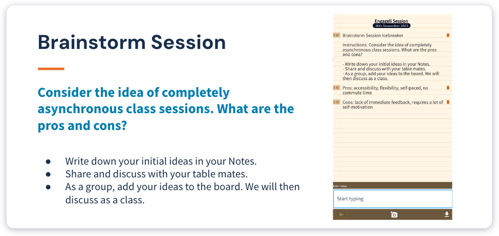
10. Meta-Icebreaker Discussion
How it works: Arrange your learners into small groups and present them with the following questions: "What is the best icebreaker you’ve experienced? What do you think made it successful?" Set a timer for to let the groups discuss, then ask one representative from each table to share with the whole class.
Why it's effective: It’s a two-for-one deal! You not only get everyone talking but also gather tried-and-tested icebreakers for future sessions. This gives you new ideas and also helps you understand what engages your class.
Implementation tips: Set a clear timeframe (e.g., 5 minutes for discussion, 5 minutes for sharing). Capture learner suggestions for potential use in future sessions.
Variations:
- Learning preferences: Discussing how students learn most effectively
- Communication styles: Exploring different approaches to virtual interaction
- Feedback mechanisms: Identifying helpful ways to give and receive feedback
- Community building: Brainstorming ways to strengthen class connection
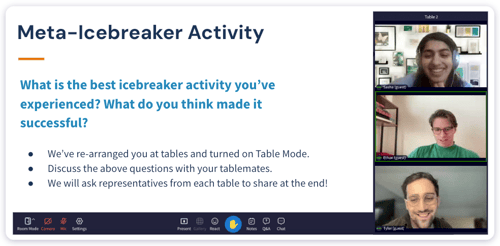
Reflection and Discussion Starters (10-15 minutes)
11. Quote Reactions
How it works: Share a thought-provoking quote related to the course subject. Ask learners to reflect on their reaction to the quote and share their thoughts in small groups or with the whole class. The quote can be displayed visually or shared in chat.
Why it's effective: This connects personal perspectives to expert viewpoints to encourage critical thinking. It provides a structured entry point into deeper discussions about course themes.
Implementation tips: Select quotes that offer multiple interpretations or potentially controversial perspectives. Provide prompts for reflection, such as "What assumptions underlie this statement?" or "How does this connect to your experience?" Make sure to allow for individual reflection time before discussion.
Variations:
- Controversial statements: Provocative viewpoints that stimulate debate
- Historical perspectives: Quotes from different time periods showing evolution of thought
- Future predictions: Statements about the future of the field
- Interdisciplinary connections: Quotes that bridge the course subject with other disciplines
12. Misconception Challenge
How it works: Present common misconceptions related to the course content. Ask students to identify which they previously believed and discuss how their understanding has evolved or what evidence changed their mind.
Why it's effective: This activates prior knowledge, normalizes the process of changing one's mind, and creates a foundation for addressing misconceptions throughout the course. It models intellectual humility and evidence-based thinking.
Implementation tips: Create a safe environment by sharing your own previous misconceptions first. Use polling to anonymously identify common misconceptions in the class. Frame the activity as an exploration of how knowledge evolves rather than a test of correctness.
Variations:
- Myth busters: Debunking common myths in the field
- Fact checking: Evaluating claims from media or popular sources
- Evolution of understanding: Tracing how knowledge in the field has changed
- Prediction correction: Revisiting previous predictions about the subject
13. Learning Journey Map
How it works: Provide a template for students to visualize their journey with the subject matter - past experiences, current position, and future goals. Students create individual maps, then share in small groups or through gallery-style viewing.
Why it's effective: This metacognitive activity builds learning awareness and helps students connect course content to their broader educational and professional paths. It provides context for the instructor and helps students articulate their learning objectives.
Implementation tips: Offer a simple visual template with sections for past, present, and future. Provide prompts for each section, such as "Key experiences that shaped your interest" or "How you hope to apply this knowledge." Allow creative expression through different formats.
Variations:
- Future projections: Focusing on applications and aspirations
- Obstacle identification: Mapping challenges and strategies to overcome them
- Milestone celebration: Highlighting key achievements in the learning journey
- Skill development: Tracking the evolution of specific competencies
14. Values Discussion
How it works: Present a list of values related to the subject area (e.g., innovation, accuracy, accessibility, sustainability). Ask students to select their top three values and explain how these influence their approach to the field. Discussion can occur in small groups or through a shared document.
Why it's effective: This connects course content to personal meaning and helps students articulate their motivations. It reveals diversity in priorities and perspectives while establishing a foundation for discussing ethical dimensions of the subject.
Implementation tips: Provide a comprehensive list of values relevant to the field, with brief definitions if needed. Allow time for individual reflection before sharing. Look for patterns in class responses and discuss implications for collaborative work.
Variations:
- Professional ethics: Focusing on values in workplace contexts
- Disciplinary values: Exploring core values of the field or discipline
- Application contexts: Discussing how values manifest in different settings
- Value tensions: Identifying potential conflicts between different values
15. Case Study Reactions
How it works: Present a brief, engaging case study related to the course content. Ask students to share their initial reactions, questions, or approaches before doing a detailed analysis. This can be done through polling, chat responses, or small group discussion.
Why it's effective: This applies concepts to realistic situations, making abstract ideas more concrete. It activates critical thinking and helps students connect theory to practice while revealing diverse perspectives on complex issues.
Implementation tips: Select case studies that are accessible to beginners but have enough complexity for discussion. Provide a structured format for initial reactions, such as "What stands out to you?" or "What would you want to know more about?" Save deeper analysis for later in the session.
Variations:
- Historical cases: Examining real situations from the past
- Current events: Analyzing recent developments related to the field
- Hypothetical scenarios: Exploring potential future situations
- Personal experiences: Sharing relevant encounters with the subject matter
Team-Building Games (15-20 minutes)
16. Speed Networking
How it works: Similar to speed dating, this involves pairing learners for brief, timed conversations. They can discuss predefined topics or share something about themselves, like a personal story or hobby. You can rotate pairs as many times as you would like, allowing learners to connect with a wide range of classmates.
Why it's effective: This method allows learners to meet multiple peers in a short period of time. These quick conversations help build community among learners and discover common interests. Plus, the rapid pace keeps everyone engaged!
Implementation tips: Prepare 3-5 conversation prompts that progress from lighter topics to more course-relevant discussions. Clearly explain the rotation process before beginning. Consider having students take brief notes about what they learn from each partner.
Variations:
- Structured questions: Specific prompts for each rotation
- Peer interviews: Learners gather specific information from each partner
- Concept explanations: Learners teach each other different course concepts
- Problem-solving pairs: Each rotation addresses a different challenge
17. Expertise Exchange
How it works: Begin this activity by asking your learners the following question: "What's something you could speak about for 30 minutes, without any preparation?" Encourage them to reflect on their interests, skills, and experiences. Then, invite everyone to write their topic on a sticky note and add it to a class-wide virtual whiteboard.
Why it's effective: This icebreaker not only gives learners space to reflect on their own areas of expertise and interest but also builds community and common ground among your class. Following the sharing on the whiteboard, you can ask learners to briefly speak about their area of expertise to promote public speaking on a comfortable topic.
Implementation tips: Create a structured format for sharing expertise (topic, experience level, willingness to help others). Compile responses into a class directory that can be referenced throughout the term. Consider following up with mini-teaching opportunities.
Variations:
- Teaching mini-lessons: Learners volunteer to share brief tutorials
- Resource sharing: Learners contribute helpful resources in their areas of knowledge
- Mentoring pairs: Matching learners based on complementary skills
- Expert panels: Grouping learners with similar expertise for Q&A sessions
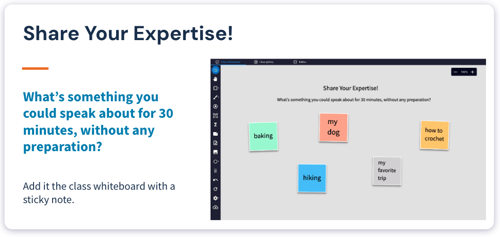
18. Virtual Scavenger Hunt
How it works: Organize a virtual scavenger hunt by creating a list of items, ranging from common household items to more quirky objects that learners can find in their homes. Share this list with your learners and set a countdown timer with just enough time to add a sense of urgency. Then, send your learners out into their homes to find the items. Once the countdown is over, they can share their finds on camera with the class.
Why it's effective: This activity is lively and interactive, getting learners moving and adding an element of friendly competition. It's a great way to energize the class and bring in some fun. Plus, you'll get to know more about your learners based on the items they share.
Implementation tips: Include a mix of common items (book, plant) and more creative challenges ("something older than you," "something that represents your field of study"). Consider accessibility by offering alternatives for learners with mobility limitations or those in limited spaces.
Variations:
- Course-related items: Objects that connect to concepts or terminology
- Conceptual hunts: Finding representations of abstract ideas (e.g. find an item that represents happiness or persistance)
- Digital hunts: Searching for online resources or examples
- Photo hunts: Finding photos that meet certain criteria
19. Collaborative Drawing Challenge
How it works: Divide students into small teams and assign each team a course-related concept to illustrate collaboratively. Using digital whiteboard tools, teams work together to create a visual representation, then present their creation to the class.
Why it's effective: This creative activity combines visual thinking with content reinforcement while building teamwork skills. It appeals to visual learners and helps make abstract concepts more concrete through metaphor and imagery.
Implementation tips: Provide clear instructions for using the collaborative drawing tools. Assign concepts that lend themselves to visual representation. Allow 7-10 minutes for creation and 3-5 minutes for presentations and discussion.
Variations:
- Course concept visualization: Illustrating key theories or ideas
- Process diagrams: Creating visual representations of procedures or sequences
- Metaphor creation: Developing visual metaphors for complex concepts
- Mind mapping: Collaboratively mapping relationships between ideas
20. Virtual Escape Room
How it works: Create a simplified escape room experience with 3-5 course-related puzzles or challenges that teams must solve together. Using breakout rooms, teams work collaboratively to "escape" by solving all puzzles within a set timeframe.
Why it's effective: This immersive activity builds problem-solving skills and teamwork while reinforcing course concepts. The game format increases engagement and creates shared experiences that strengthen group bonds.
Implementation tips: Design puzzles that can be solved through digital collaboration. Provide clear instructions and a way for teams to check their answers or request hints. Consider using Google Forms or similar tools to create self-checking puzzles.
Variations:
- Content-based challenges: Puzzles that review or apply course material
- Historical scenarios: Challenges set in a time period relevant to the course
- Ethical dilemmas: Problems that require weighing different perspectives
- Career simulations: Scenarios related to professional applications of course content
Creative Activities (15-20 minutes)
21. Six-Word Stories
How it works: Challenge students to create six-word narratives about course concepts, their learning experiences, or applications of the subject. Students share their micro-stories in chat, on a collaborative document, or verbally.
Why it's effective: This creative constraint encourages precise thinking and expression, making it an excellent critical thinking exercise. The brevity makes participation accessible while still allowing for powerful insights and memorable phrases.
Implementation tips: Share examples of effective six-word stories in different contexts. Allow time for drafting and revision. Consider creating a class collection of the most impactful stories for future reference.
Variations:
- Course summaries: Distilling key concepts into six words
- Learning goals: Expressing aspirations in concise form
- Concept definitions: Capturing the essence of complex ideas
- Personal connections: Relating course material to individual experience
22. Emoji Translation
How it works: Ask students to represent a course concept, process, or personal learning journey using only emojis. Students share their emoji sequences and others try to interpret them, followed by creator explanation.
Why it's effective: This playful activity encourages visual thinking and creative expression while making abstract concepts more approachable. It appeals to digital natives and provides a refreshing alternative to text-based communication.
Implementation tips: Demonstrate with an example of your own emoji translation. Provide access to an emoji reference chart for those less familiar with options. Consider creating categories or specific challenges to focus the activity.
Variations:
- Concept summaries: Representing key ideas through emoji
- Emotional journeys: Depicting feelings throughout a learning process
- Process steps: Showing sequences or procedures with emoji
- Reaction chains: Expressing responses to course material
23. Headline Creation
How it works: Ask students to write newspaper-style headlines about course concepts, as if major developments in the field were breaking news. Headlines can be shared in chat, on a collaborative document, or through a virtual "front page" collage.
Why it's effective: This synthesizes information in an engaging format, encouraging students to identify key aspects of concepts and express them concisely. It adds creativity and contemporary relevance to academic content.
Implementation tips: Show examples of effective headlines that use wordplay, alliteration, or surprising juxtapositions. Encourage various journalistic styles (tabloid, academic journal, local newspaper). Consider voting for the most creative or accurate headlines.
Variations:
- Future predictions: Headlines from 10 years in the future
- Historical perspectives: Headlines from different time periods
- Different audiences: Headlines targeting various stakeholder groups
- Interdisciplinary connections: Headlines connecting the course to other fields
24. Meme Generation
How it works: Challenge students to create or adapt memes related to course content. Using simple meme generator tools or templates, students develop visual humor that demonstrates understanding of concepts. Memes are shared in a gallery format for appreciation and discussion.
Why it's effective: This connects academic content to popular culture, making it more relatable and memorable. It encourages creative thinking about concepts and creates shared references that can be used throughout the course.
Implementation tips: Provide examples of appropriate academic memes and clear guidelines about respectful humor. Offer simple creation tools or templates for those unfamiliar with meme creation. Discuss how the humor in each meme relates to course concepts.
Variations:
- Historical figures: Memes featuring key individuals in the field
- Theoretical concepts: Visual jokes about complex ideas
- Disciplinary humor: Memes about experiences in the field
- Learning process: Humorous takes on the student experience
25. Soundtrack Selection
How it works: Ask students to choose songs that represent course concepts, themes, or their learning experience. Students share their selections with brief explanations of the connection. This can be done through a collaborative playlist, discussion board, or live sharing.
Why it's effective: This creates emotional connections to academic content through the powerful medium of music. It helps students think metaphorically about concepts and provides a diverse range of perspectives on course material.
Implementation tips: Provide examples of songs with clear connections to concepts. Allow sharing of just the title and artist rather than playing full songs to manage time. Consider creating a class playlist that can be accessed throughout the term.
Variations:
- Historical periods: Music representing different eras relevant to the course
- Emotional states: Songs that capture feelings associated with learning
- Concept relationships: Music that metaphorically represents key ideas
- Learning soundtrack: Compilation of songs that support different study activities
Integrating Icebreakers into Your Teaching Strategy
Rather than treating icebreakers as isolated activities, integrate them into your broader teaching approach:
- Create an icebreaker library of activities that work well for different contexts, group sizes, and purposes. Categorize them for easy reference based on time required, technology needed, and learning objectives.
- Plan a progression of icebreakers sequenced throughout the term that evolves as students become more comfortable with each other. Start with lower-risk activities and gradually introduce more collaborative or reflective exercises as trust builds.
- Whenever possible, design icebreakers that reinforce key concepts or skills from your course curriculum. This integration helps students see the relevance of the activities to their learning goals.
- Use early icebreakers to identify potential project partners based on complementary skills or interests. Reference connections made during icebreakers when forming teams for more substantial collaborative work.
- As the term progresses, invite students to design and facilitate their own icebreakers. This builds leadership skills and ensures activities remain fresh and relevant to student interests.
Incorporating these icebreakers in your virtual classrooms will not only warm up your sessions but will be the first step in creating an active learning environment. Active teaching, unlike traditional methods of passive learning, allows you to foster a community of active learners who are comfortable, engaged, and ready to collaborate. The key to a successful icebreaking session is to be inclusive, encouraging, and most importantly, to have fun.
Happy teaching!
Want to learn more about creating engaging and impactful virtual sessions? Check out the results from the Active Learning Impact Study. This research study found that active learning virtual sessions can create a 13x increase in talk time, 16x more nonverbal engagement, and test scores 54% higher when compared to passive learners in a traditional lecture setting.
![]() Interested in experiencing Engageli's new features firsthand?
Interested in experiencing Engageli's new features firsthand?
Try our new immersive experience to explore the Engageli platform!


